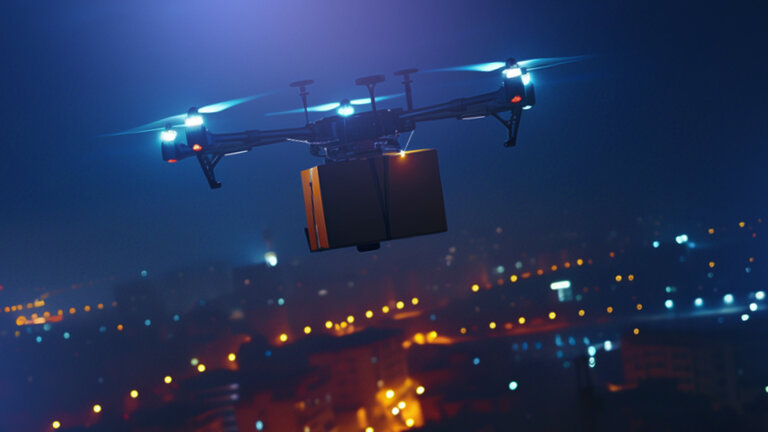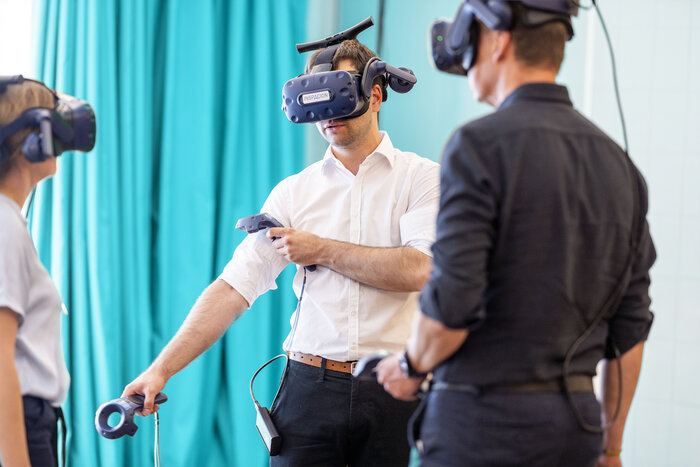Logistics of the future

Storing, picking, and transporting: even if the core tasks of logistics remain the same, the sector is becoming increasingly important. The requirements are also increasing as courier, express and package service providers need to be faster, more precise and more environmentally friendly.
Logistics trends of the future
Driverless trucks transport goods picked by robots to the rear entrance of zone A. The order is a carnivorous houseplant for family Z and is delivered to the family’s apartment via a fully automated, app-controlled elevator. Henning Z., who ordered the plant just two hours earlier via telepathy, is surprised that there is no drone today.
Albeit fictitious, this scenario is no longer so far-fetched. This is because the logistics industry is undergoing radical change. Instead of large logistics centers on greenfield sites, there are more and more decentralized, flexible solutions in city centers, for example. So-called micro-hubs bring speed to logistics and make use of unused or otherwise difficult-to-use spaces in underground parking lots or shopping centers. Dark stores are another phenomenon. These include, for example, former supermarkets that have been converted into fulfillment centers. Instead of being used as traditional shopping spaces, they are used to fulfill online orders. One example of this is the stores of the US chain Whole Foods, which was acquired by Amazon in 2017.
Digitalization in logistics
The industry has also undergone an image change in recent years. Logistics is no longer just the sometimes seemingly mundane task of storing goods and then transporting them from A to B. The entire retail sector, both online and stationary, is dependent on a functioning logistics network and has identified it as central to its business. Amazon Logistics has been using its own package service to tap into a new business area for years, thereby broadening its added value.
Digitalization and artificial intelligence are also giving logistics an extreme boost. Blockchain solutions are conceivable, for example to ensure forgery-proof freight documents. Self-controlling, fully automated processes are also plausible along the entire supply chain and therefore also within warehouse logistics. Digitalizing logistics processes makes the supply chain more efficient. Drees & Sommer’s Equipment Performance team of experts develops and implements assembly lines, among other things, and can therefore bring entire factory halls up to a future-proof standard.
Logistics concepts for the final mile
It’s not just the warehouse itself that is changing. There is still a lot of movement in the final mile. Companies are asking themselves about the best way to get their goods from the micro-hub or medium-sized logistics center to the customer’s doorstep. They want to do so as quickly as possible, as economically as possible, and preferably in a climate-neutral way. When developing a new neighborhood, the logistics concept is therefore high on the agenda. Drees & Sommer takes on the overall coordination for project developers, from analyzing requirements and space to a market overview of various providers and implementation of the concept.
City logistics concept
At Quartier Heidestraße, within Berlin’s Europacity, a user typology visualized who will live and work there. The resulting user requirements are also valuable information from a logistics perspective because people will order certain goods and receive deliveries. At Quartier Heidestraße, for example, an area in the rear storage room of a late-night store (known by the German word „Spätis”) is planned as a 24/7 micro-hub.
The residential neighborhood has different options for receiving or sending packages, depending on the quality of living and user group. Residents can either collect them themselves from the micro-hub when the late-night store is open or they can have the packages delivered to their front door by cargo bike for an extra charge of 1 euro. Another option is to distribute the package to one of the white label package boxes in the neighborhood, where users can then collect the package themselves. The package can also be delivered directly to the house via an app and with a video camera system that lets the package carrier through the front door via remote control. Drees & Sommer is involved in another neighborhood in the eastern Hamburg area of Oberbillwerder, where an agile logistics concept is being built.

Drones in logistics
How can neighborhoods with little car traffic be connected to the flow of deliveries and goods? The answer of drones is obvious to many, but even though the aircraft are already being used in many (test) applications—e.g. the delivery of medicines or lightweight vehicle parts—it is unlikely that they will play a significant role in inner-city transport logistics in the near future. This is because they are still too susceptible to technical faults and legal regulations severely restrict their use in cities. Alternatives include underground deliveries or app-controlled deliveries directly to the home.
What about beaming? To put it simply and unscientifically: it does not contradict any laws of physics and is therefore possible in principle. However, the effort involved is so immense that it is difficult to say whether and when entire products can be teleported. This means that for the foreseeable future, comprehensive logistics expertise that is interlinked with other sectors and topics will remain more than in demand.
You can find more information on logistics real estate here.
The article was edited // Original contribution from November 2021





